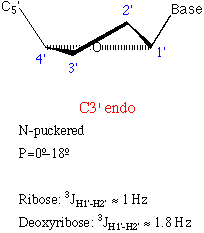The ribose sugar geometry is defined by the following five endocyclic torsion angles:
The magnotudes of such angles are all interrelated and, therefore, the geometry of the ribose ring can be defined from two parameters: the pseudorotation phase angle (P) and the pucker amplitude. The ribose ring is not aplanar and usually presents C2'-endo (South) or C3'-endo (North) conformation.
For the sugar pucker conformation, homonuclear 3JH-H coupling constant serve as the most direct determinant ( 01JB19-19). These constants can be measured in a qualitative way from 2D 1H-1H TOCSY, 2D 1H-13C TOCSY-HMQC or 2D 1H-13C TOCSY-HSQC experiments:
- Very weak JH1'-H2' and strong JH3'-H4' cross-peaks correspond to pure N-type conformation (preferred conformation in RNA).
- Strong JH1'-H2' and weak JH3'-H4' cross-peaks correspond to pure S-type conformation.
- JH2'-H3' is similar in both states.
- Intermediate intensities indicate an equilibrium between N and S states.

Other coupling constants in the sugar ring:
Sugar puckering can also be studied from:
- 1JCH coupling constants:
- 1JC1'-H1' in the range 166.0-170.0 Hz
- All other pairs in the range 145-153 Hz
- 1JCC coupling constants:
- 1JC1'-C2' and 1JC4'-C5' in the range 42.0-43.5 Hz
- 1JC2'-C3' and 1JC3'-C4' in the range 37.5-38.5 Hz